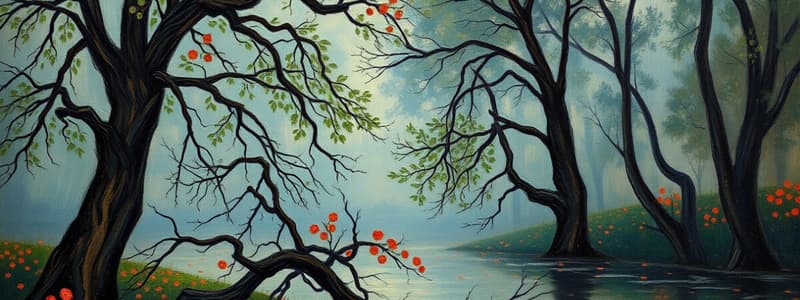Podcast
Questions and Answers
What allows the poet to see the tiny speck on the paper?
What allows the poet to see the tiny speck on the paper?
- The poet's keen eyesight
- The bright white color of the paper (correct)
- The way the light reflects off the paper
- The size of the speck itself
What is the poet's initial thought about the tiny speck before closer observation?
What is the poet's initial thought about the tiny speck before closer observation?
- It is a mark from his pen
- It is a dust speck blown by his breath (correct)
- It is a blob of ink
- It is a living creature
How does the mite behave as observed by the poet?
How does the mite behave as observed by the poet?
- It is blown around by air currents
- It frequently stops to rest
- It crawls aimlessly without a direction
- It moves with self-directed purpose (correct)
What momentarily causes the mite to pause?
What momentarily causes the mite to pause?
What action is the poet about to take with his pen when he first notices the speck?
What action is the poet about to take with his pen when he first notices the speck?
What does the poet ultimately conclude about the speck?
What does the poet ultimately conclude about the speck?
What literary effect does the bright white paper offer to the poet's writing experience?
What literary effect does the bright white paper offer to the poet's writing experience?
What emotion does the poet feel regarding the mite's movement?
What emotion does the poet feel regarding the mite's movement?
What triggers the mite's hesitation when it reaches the wet ink on the manuscript?
What triggers the mite's hesitation when it reaches the wet ink on the manuscript?
What realization does the poet come to about the mite's movements?
What realization does the poet come to about the mite's movements?
What sentiment does the poet express towards modern collectivist love?
What sentiment does the poet express towards modern collectivist love?
How does the poet decide to treat the mite at the end of the poem?
How does the poet decide to treat the mite at the end of the poem?
What does the poet mean when he mentions 'the least display of mind'?
What does the poet mean when he mentions 'the least display of mind'?
What does the poet imply about the mite's physical characteristics?
What does the poet imply about the mite's physical characteristics?
What deep emotional reaction does the poet have towards the mite's fate?
What deep emotional reaction does the poet have towards the mite's fate?
What does the phrase 'to express how much it didn't want to die' suggest about the mite's behavior?
What does the phrase 'to express how much it didn't want to die' suggest about the mite's behavior?
What is the poet's view on intelligence as it relates to living beings?
What is the poet's view on intelligence as it relates to living beings?
What does the poet hope will happen to the mite after leaving it on the manuscript?
What does the poet hope will happen to the mite after leaving it on the manuscript?
Flashcards are hidden until you start studying
Study Notes
The Poet and the Tiny Mite
- The poet notices a minuscule speck on a bright white paper, which would typically go undetected.
- The stark contrast of the white sheet enables the poet to see the tiny, otherwise invisible speck.
- As the poet writes, he observes the speck moving, revealing it to be a living mite rather than just a dust particle.
- The tiny mite exhibits purposeful movement, demonstrating self-direction as it navigates the paper.
- It pauses briefly, seemingly wary of the poet's pen, indicating a sense of caution and intelligence.
- Upon reaching damp ink, the mite hesitates and appears to investigate, only to recoil from the unpleasant scent or taste.
- The poet marvels at the mite's intelligence, noting its minute size yet obvious possession of a complete set of legs.
- The mite's frantic movements suggest a strong instinct for survival, driven by both fear and cunning.
- A moment of hesitation reveals the mite's vulnerability, as it appears to surrender in the center of the blank page.
- The poet expresses his lack of excessive sentimentalism or a controlling 'collectivist' love that is prevalent in modern society.
- Despite its fragility, the poet chooses not to harm the mite, wishing instead for it to find peace as it rests on the paper.
- The poet acknowledges his recognition of intelligence in the mite, feeling a profound joy upon witnessing any display of imagination or thought, regardless of size.
Studying That Suits You
Use AI to generate personalized quizzes and flashcards to suit your learning preferences.




